
Common Snake Species in Charleston
 Queen snake:
The queen snake is a slender snake that can grow as long as three feet. They are aquatic snakes that are blackish or grayish in color. They have distinct physical features such as the yellowish stripes that are on the lower back of their bodies.
Queen snakes also have yellow bellies adorned with black stripes. They are found close to water bodies like rivers and small, rocky creeks. Queen snakes have strongly keeled scales, and their diet includes different small aquatic animals, including crayfish.
Queen snake:
The queen snake is a slender snake that can grow as long as three feet. They are aquatic snakes that are blackish or grayish in color. They have distinct physical features such as the yellowish stripes that are on the lower back of their bodies.
Queen snakes also have yellow bellies adorned with black stripes. They are found close to water bodies like rivers and small, rocky creeks. Queen snakes have strongly keeled scales, and their diet includes different small aquatic animals, including crayfish.
 Northern brown snake:
Northern brown snakes are small snakes found mostly in moist woodlands. The snakes can grow up to 20 inches in length. The northern brown snake can be identified by physical features such as the two rows of black dots that are found on their back. They also have 17 rows of keeled scales. The diet of the snakes includes different small invertebrates. They feed on slugs, insects, and earthworms.
Northern brown snake:
Northern brown snakes are small snakes found mostly in moist woodlands. The snakes can grow up to 20 inches in length. The northern brown snake can be identified by physical features such as the two rows of black dots that are found on their back. They also have 17 rows of keeled scales. The diet of the snakes includes different small invertebrates. They feed on slugs, insects, and earthworms. 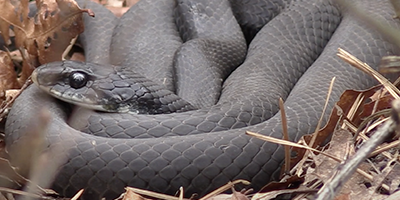 Northern black racers:
The northern black racer is one of the commonest non-venomous snakes found in Charleston, West Virginia. They are known for the speed at which they move, particularly when they are provoked. The snakes can be particularly aggressive when they are attacked.
These snakes have smooth scales and are black in color. The common habitats of the northern black racers are basements and old barns. They enter these habitats in search of their food which can be rats and small reptiles.
Distinct physical features of the northern black racer are the black color and the white throat patch.
Northern black racers:
The northern black racer is one of the commonest non-venomous snakes found in Charleston, West Virginia. They are known for the speed at which they move, particularly when they are provoked. The snakes can be particularly aggressive when they are attacked.
These snakes have smooth scales and are black in color. The common habitats of the northern black racers are basements and old barns. They enter these habitats in search of their food which can be rats and small reptiles.
Distinct physical features of the northern black racer are the black color and the white throat patch.
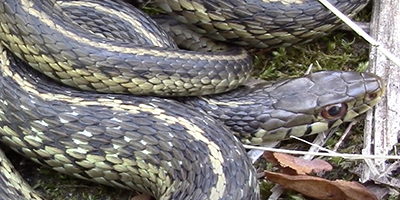 Eastern garter snake:
These snakes make their habitats out of different environments and are commonly encountered. The eastern garter snake can live in buildings, marshes, hillsides, and building lots. The color of the snakes also varies. They can be brownish, grayish, or greenish.
Eastern garters can grow as long as four feet. They feed on small animals and can be attracted to an area because of the presence of small animals like rodents.
Eastern garter snake:
These snakes make their habitats out of different environments and are commonly encountered. The eastern garter snake can live in buildings, marshes, hillsides, and building lots. The color of the snakes also varies. They can be brownish, grayish, or greenish.
Eastern garters can grow as long as four feet. They feed on small animals and can be attracted to an area because of the presence of small animals like rodents.
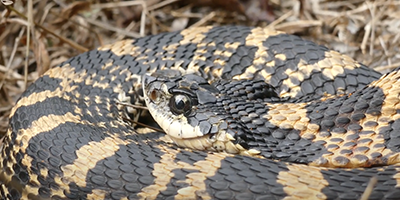 Eastern hognose snake:
The eastern hognose snake is known for the unique behavior it displays when it is threatened. The snake inflates its body with air and flattens its neck and head as a defensive position when hissing and striking at a predator.
Eastern hognose snakes get their name from their upturned short and flat snout which can be likened to a pig’s nose. These snakes can also play dead when they feel threatened. They simply roll over and play dead like an opossum.
Eastern hognose snake:
The eastern hognose snake is known for the unique behavior it displays when it is threatened. The snake inflates its body with air and flattens its neck and head as a defensive position when hissing and striking at a predator.
Eastern hognose snakes get their name from their upturned short and flat snout which can be likened to a pig’s nose. These snakes can also play dead when they feel threatened. They simply roll over and play dead like an opossum.
Venomous Snake Species in Charleston
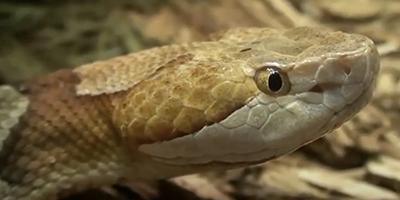 Northern copperhead:
This venomous snake is found in different parts of West Virginia, including Charleston. The snake has characteristic features such as the copper color of its head. The northern copperhead is one of the two venomous snakes of West Virginia.
Northern copperheads are most commonly found in the woods. The snakes are not known to be aggressive. Even though they prefer to be left alone, northern copperheads can strike at predators or intruders from a distance and release venom in their bites. Copperheads do not rattle but they can be identified based on their characteristic physical features. The hourglass-shaped crossbands on the back of the snakes is a noteworthy distinguishing feature.
Northern copperhead:
This venomous snake is found in different parts of West Virginia, including Charleston. The snake has characteristic features such as the copper color of its head. The northern copperhead is one of the two venomous snakes of West Virginia.
Northern copperheads are most commonly found in the woods. The snakes are not known to be aggressive. Even though they prefer to be left alone, northern copperheads can strike at predators or intruders from a distance and release venom in their bites. Copperheads do not rattle but they can be identified based on their characteristic physical features. The hourglass-shaped crossbands on the back of the snakes is a noteworthy distinguishing feature.
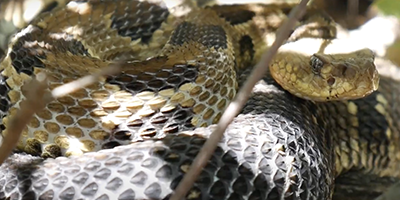 Timber rattlesnakes:
Timber rattlesnakes are encountered in Charleston, West Virginia, particularly in high mountainous areas. The rattling sounds of the snakes can be used to identify them. The snakes can grow as long as four feet. They have two color phases, the yellow and black phases. The phase of the rattlesnake determines its color as it can be golden yellow or black.
In West Virginia, the snakes are mostly found in higher elevations. The bites of the rattlesnakes are severe, as the venom is more potent than that of copperheads.
Timber rattlesnakes:
Timber rattlesnakes are encountered in Charleston, West Virginia, particularly in high mountainous areas. The rattling sounds of the snakes can be used to identify them. The snakes can grow as long as four feet. They have two color phases, the yellow and black phases. The phase of the rattlesnake determines its color as it can be golden yellow or black.
In West Virginia, the snakes are mostly found in higher elevations. The bites of the rattlesnakes are severe, as the venom is more potent than that of copperheads.